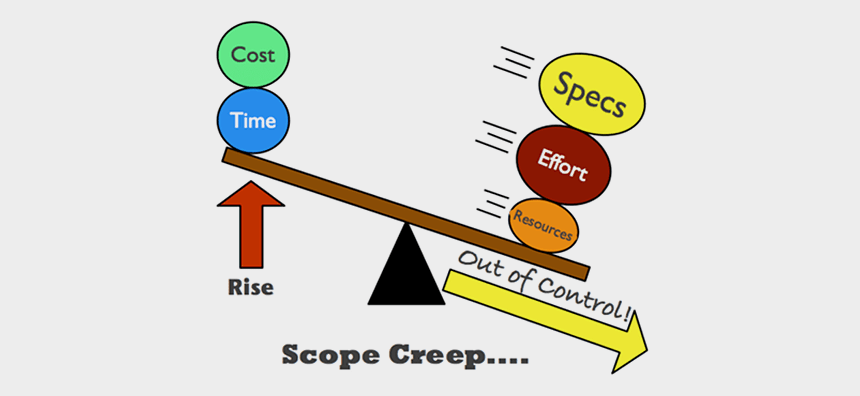
Click the button to start reading
For additional information on this topic, feel free to check out this Youtube video from our channel.
Now, onto the main content...
How to Overcome Challenges in Project Management—The New Manager’s Guide
Every project is unique. The people, the problems, the creative solutions, the setbacks—the experience of managing a project never repeats itself exactly.
But even so, there are similarities between all projects. There are common roadblocks which appear out of nowhere, and there are common solutions to help overcome them. Our focus in this post is looking at these project management challenges and sharing practical advice you can follow to overcome them.
This article is especially targeted at inexperienced project managers. If you haven’t been around the block and seen it all before, then this will help you bridge the gap to that experience and allow you to tackle unexpected problems with confidence.

Scope creep
“Scope creep” is when, over the course of a project, the requirements and outcomes grow beyond your initial predictions. Usually this is the result of repeated, minor requests:
- Can we adjust this piece of functionality?
- Actually I thought it would look more like this.
- Can you add this little thing in? It shouldn’t take long…
And because these are minor requests, project managers usually accept them. Scope creep causes problems for more than half of projects but, at the end of the day, you need to do what the client wants…right?
How to make scope creep impossible
In the vast majority of cases, scope creep doesn’t occur because the client changes their mind—it happens because they didn’t know what they wanted in the first place.
So the solution is incredibly simple: planning.
More than one challenge on this list eventually comes back to better planning. “Failing to plan is planning to fail” might be a cliché, but it’s also extremely apt. Right at the outset of your project, it’s crucial to get 100% buy-in from all key stakeholders (i.e. your senior management and/or the client) and make sure the end deliverables are written down in clear, concrete text and signed off.
Yes, this will require more input and effort upfront. And yes, sometimes precisely quantifying your end goals can be challenging, but it’s always valuable. Your client isn’t going to give you carte blanche to spend as much time and resources as you like—so why would you give them unlimited scope to cherry pick changes throughout the project?
More to the point, it’s impossible (as we’ll see) to budget for a project without strict requirements and outcomes. So get all of the requirements signed off early so that, down the line, the client can’t come back asking for tweaks. And if they do…

Handling scope changes like a pro
Occasionally a client actually changes their mind. They’ve bought into the initial agreement but now something’s changed and so have their requirements.
This is absolutely nothing to worry about if it’s handled correctly. Here’s what you do:
- Get the full details of what the client wants. No vague ideas, but concrete concepts and outcomes.
- Calculate the effect on the project:
- Does this require extra time, personnel or capital?
- Is work being directly replaced, removed, or added?
- Can we still meet the original deadline? If so, do we risk compromising quality?
- Does our team have the skillset to deliver these changes?
- Present those results to the client. “We can deliver your changes BUT:
- “It will increase our fee by $X” or,
- “We’ll need a contractor for Y hours”, or
- “The delivery date will need to be pushed back by Z days”, etc
- Get approval sign-off on the new changes then get to work
- No approval? No changes!
Sometimes your client isn’t going to like this—if they’re used to getting extra for their money, they might kick up a fuss. Stay strong! You’re completely in the right and acting as the consummate professional, so stick to your guns.
Once the client agrees, this is no longer scope creep; it’s just calculated scope change and you are still in complete control of your project.

Budget overrun and unplanned costs
By far your biggest asset when it comes to budgeting is realistic, conservative estimates from the get-go. You need to put in the hours early, making sure that predictions for materials, shipping, talent, resources and whatever else you need are as realistic as possible.
This will put you in the best possible position. However, things can and will go awry. For a start, there’s scope creep. But if you’ve followed our advice in the previous section, then everyone is agreed on the key deliverables, cost and timeline, making scope creep impossible. (Requests for changes, big or small, are now met with changes in terms!)
The 3 other main contributors to budget problems are:
1. Mistakes during planning
Despite your best efforts, sometimes there’s a miscalculation, a bad estimate, or another human error that doesn’t surface until later into the project. In this case, you need to find a solution—but this time you can’t request increased time or funds from the client.
It might be pulling some extra hours, finding creative fixes to save cash elsewhere, or a thousand other solutions. Great planning will minimize these errors but you, as project manager, must always be ready for them.
2. Poor project execution
Whether due to low motivation from the team, overestimated skills during planning, or something as simple as not tracking the project adequately, your costs can quickly spiral. Using a planning tool like Teamly to manage your communications and tasks can keep you on-track (and on-budget) through any project.
3. Economic factors outside of your control
If a massive pandemic hits and drives up the cost of shipping by 1,000%, you need to sit down with the client and figure something out. These problems are no one’s fault, but it’s still your responsibility to find the best way forward and rescue the situation as much as possible.
Most budget-related problems can be prevented with proactive measures before the project kicks off. After that, it’s all about creatively finding solutions and maintaining clear communication with the client.

Poor engagement from stakeholders and senior management
In theory, when managing a project, everything from your level down is within your control. You can keep tabs on what’s happening, encourage faster work, solve problems, and generally keep the whole chain running smoothly. That’s a demanding role, but by regularly overcoming its challenges, you can certainly fulfil it.
But there is unfortunately a ceiling to your influence: everyone, internal or external, that ranks above you.
Of course not all senior managers, executives, external partners and clients are a problem. In fact most, while busy people in their own right, will be supportive and make their time available when it’s needed.
But if they don’t…what then?
Uninvolved clients
A huge stumbling block appears when you’re managing a project for an external client and they just aren’t engaged; they don’t actively participate or keep themselves in the loop. That is, until the project nears its conclusion and they return full of vibrant energy to tell you that everything’s wrong and they aren’t happy.
The solution? Forcefully involve them from the start.
If this sounds patronizing, don’t worry—it’s your project and you’d rather go overkill on communications than risk a late-stage flop. Involve your client by booking them into necessary calls and using email/IM for verbal confirmation that they’re satisfied at each stage. Use these meetings to request actionable feedback and get their investment in the project.
If the client states upfront that they’re extremely busy, make sure you agree either a recurring meeting dedicated to the project, or permission to steamroll ahead if they’re too busy to contribute. (From our experience, they’ll quite quickly agree to the regular meeting!)
Slow approval from management
There’s less pressure on this one because, realistically, your boss (or your boss’s boss) isn’t going to fire you for pestering them; if anything, they’ll quietly approve of your eagerness.
If your team has hammered out a ton of great work and then everything grinds to a halt while you wait, impatiently, for a signature from on high, the simplest solution is to keep on knocking.
Bring it up on calls, in the cafeteria, via email—as long as you make approval or feedback as easy to give as possible, so it takes minimal time and thought, you should get it done quickly and your project can keep forging ahead.
Quietly sitting, hoping they saw that one request buried in that one email…that’s a recipe for standstill traffic!

Skills shortage within the team
It’s an unfortunate reality in the world of project management that you don’t always get to hand-pick your team.
If that’s the case, then before making your comprehensive project plan, you need to firmly evaluate the resources (i.e. skills, knowledge and people) at your disposal. You need to know the limits of every person within the team. You can’t plan for complex software deliverables if there’s no coding expertise in the team.
But what if your skills shortage only becomes apparent partway through the project? Well, you need to revise your plan of action. Sit down with each team member and get their strengths, weaknesses and limits written out.
Once you know the limits of each team member, you should look over your plan and re-assess: what outcomes can realistically be achieved with the skills (and time) at your disposal? Does the project scope need to change, or can you recruit external skills to meet the shortfall?
The ability to navigate unexpected skills shortages is an attribute that separates an average project manager from a great one.

Lack of accountability within the team
This is something every project manager comes across before too long: a lack of investment in the project by another employee or contractor.
You don’t need every team member bouncing off the walls in excitement, but a lack of accountability can quickly spiral into apathy, and apathy derails projects.
There are two easy-to-implement solutions. The first is using a project management software (such as Teamly) to visibly assign tasks to team members, including the deadline, core deliverables and any helpful information in one place. If these objectives sync with their calendar, even better!
By simply increasing visibility on a task (and by stating how further work depends on their contribution) you make it much harder to shirk responsibility.
Option 2 is scheduling regular check-ins with team members. Knowing there’s a progress meeting coming up can light a fire in our bellies, as well as giving you a chance to provide specific deliverables and goals for the next meeting. Use your check-ins to provide positive feedback and encouragement—everyone gets a boost from seeing their work appreciated by the manager.

Consistently missed deadlines
First thing’s first—don’t be too hard on yourself or your team. Let’s take stock and figure out exactly where the problems are coming from. There are three main sources:
1. Your team is working too slowly or inefficiently
2. There are problems and delays totally outside your control
3. You’ve set deadlines which are too aggressive
We can tell you right now, it almost certainly isn’t #2. And if you’ve implemented the changes we suggested around skills and accountability within the team, it probably isn’t #1.
That leaves the simplest and most common reason for missed deadlines: they just weren’t realistic in the first place.
Here’s what to do
Accept that your assigned deadlines are unsustainable and nip them in the bud early. That means going back to the drawing board and rescheduling the project based on realistic timelines. These can be aggressive, but not unhittable.
A useful tactic here is to bring in the team members to ask what time they need at each stage. You’re project manager, but no one expects you to be omniscient: use their experience to accurately plan the project.
You then go back to your client or manager, explain the situation and get their sign off on the new timeline. Sure it’ll hurt having to request a big change, but it’s all in the interest of the project and you’ll be far better off in the long run.

Management software that isn’t fit for purpose
In the modern workplace, software has become an essential aid to project management. That’s a big umbrella that covers a lot of stuff: task management, time trackers, goal setting, video conferencing, instant messaging, employee monitoring and much more.
And since this often means selecting multiple vendors (and the whole screening, budgeting and presenting-to-senior-management process that goes with it) it can be an awkward part of the project.
Worse, if your tools don’t communicate perfectly with each other, your ability to execute the project effectively is jeopardized. Teamly is an all-in-one project management suite that provides everything we listed above, as well as mountains of other helpful, not-overcomplicated functionality. Built to empower teams and simplify project management, it might be just the ticket for keeping your projects running smoother than ever.
Conclusion
As you can see, the best way to solve the majority of these problems is…by preventing them with better planning in the first place! It sounds too obvious, but there really is no substitute for good, effective planning. This becomes easier as you gain experience in managing projects, but making a proactive effort to take on these lessons now will save a huge amount of time and stress in the long run.
As a project manager, you will always face problems and challenges. We hope this article helps you overcome those challenges more easily.
















